
obsidian-quiz-generator
Generate interactive flashcards from your notes using models from OpenAI (ChatGPT), Google (Gemini), Ollama (local LLMs), and more. Or manually create your own to use with the quiz UI.
Stars: 56
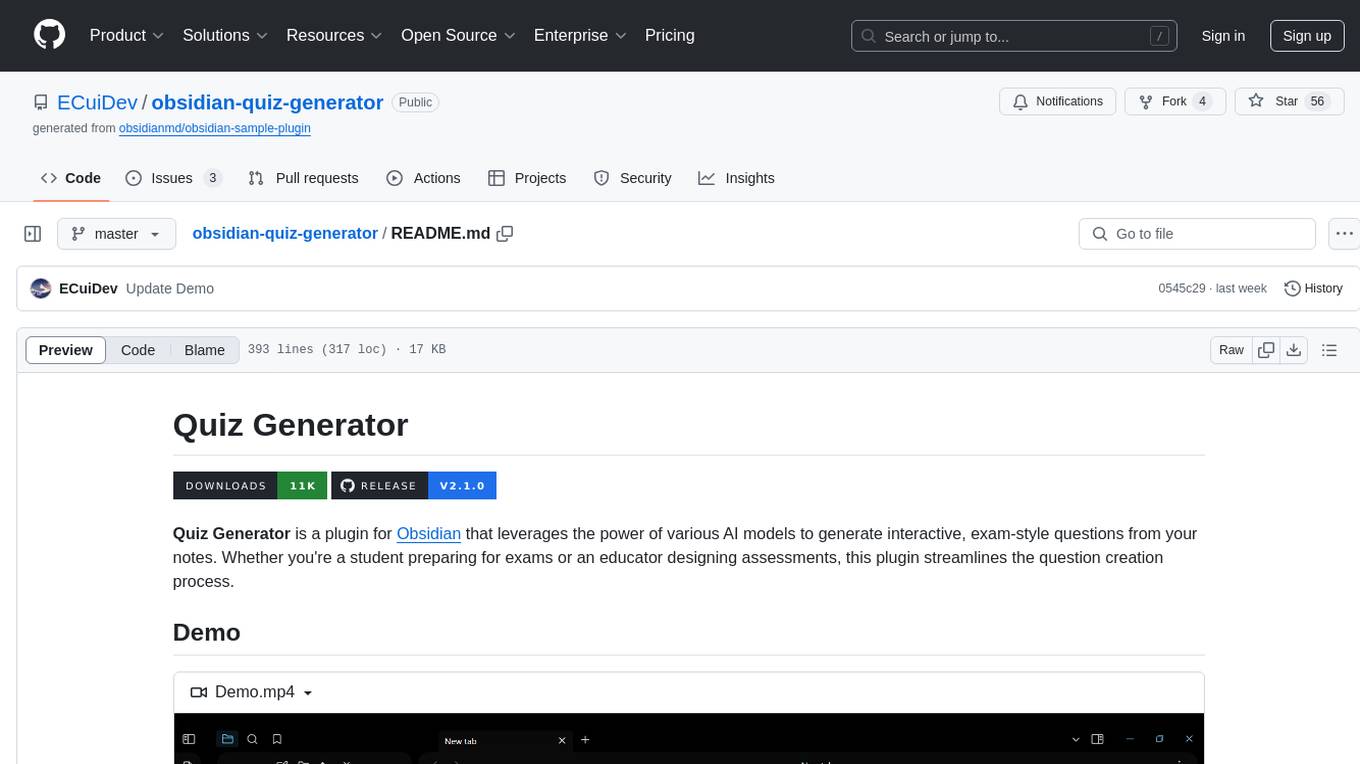
Quiz Generator is a plugin for Obsidian that uses AI models to create interactive exam-style questions from notes. It supports various question types and provides real-time feedback. Users can save questions, generate in multiple languages, and use math support. The tool is suitable for students preparing for exams and educators designing assessments.
README:
Quiz Generator is a plugin for Obsidian that leverages the power of various AI models to generate interactive, exam-style questions from your notes. Whether you're a student preparing for exams or an educator designing assessments, this plugin streamlines the question creation process.
https://github.com/user-attachments/assets/22770da4-af69-412c-ae05-1aae0fff4a10
- Personalized Quizzes: Choose any combination of notes and folders to use as the quiz content.
- Flexible Generation: Select the types and number of questions to generate according to your needs.
- Multiple Question Types: Supports true or false, multiple choice, select all that apply, fill in the blank, matching, short answer, and long answer. Mix and match for a tailored assessment experience.
- Custom Quiz UI: Answer questions in an interactive UI that provides real-time feedback on your responses.
-
Question Saving: Save questions in various formats.
- Inline and multiline flashcards compatible with obsidian-spaced-repetition.
- Markdown callouts for easy integration into your notes.
- Review and Create: Review saved questions using the quiz UI or create your own questions from scratch without ever using the generator.
- Multi-Language Support: Generate questions in 21 different languages.
- Math Support: Generate questions from notes containing LaTeX.
- OpenAI: Advanced models for high-quality question generation.
- Google: Free to use with the largest context window for handling extensive notes.
- Anthropic: Optimized for thoughtful and contextually aware outputs.
- Perplexity: Fine-tuned LLaMA models for robust question generation.
- Mistral: Lightweight models for fast and efficient processing.
- Cohere: Free to use with strengths in generating coherent questions.
- Ollama: Local LLMs for enhanced privacy and offline processing.
This plugin is now available in the Community plugins page in Obsidian. You can install it using either of the following methods.
- Install the plugin from the Community plugins page in Obsidian.
- Settings → Community plugins → Browse.
- Search for
Quiz Generator. - Select the plugin to open its page and then select Install.
- Select Enable on the plugin page or go back to the Community plugins page and toggle the switch.
- Open the plugin settings and enter your API key for the selected provider.
- If you don't have an API key, create an account at the relevant provider's site and retrieve your API key.
- Configure the other settings as desired.
- Download
main.js,manifest.json, andstyles.cssfrom the latest release. - Go to your Obsidian vault's
pluginsfolder and create a new folder namedquiz-generator. - Move the files you downloaded in step 1 to this folder.
- Enable the plugin in the Community plugins page in Obsidian.
- Open the plugin settings and enter your API key for the selected provider.
- If you don't have an API key, create an account at the relevant provider's site and retrieve your API key.
- Configure the other settings as desired.
- Open the command palette and select "Quiz Generator: Open generator" or select the brain-circuit icon in the left sidebar.
- Select the file and folder icons to add notes and folders.
- Adding a folder adds all the notes inside it, as well as any notes in its subfolders (can be changed in the settings). If you select an extremely large folder (thousands of files and hundreds of subfolders), it could take a few seconds for it to be added.
- Select the eye icon to view the contents of selected notes and folders.
- Select the x icon to remove individual notes or folders and the book icon to remove everything.
- Once you've added your notes and/or folders, select the webhook icon to generate the questions.
- The quiz UI will open automatically when the generation is complete.
- Saved questions will be in a Markdown file named "Quiz [number]" in the folder specified by the "Save location" setting.
- Select the save icon to save the current question.
- Select the save-all icon to save all questions.
- Open the command palette and select "Quiz Generator: Open quiz from active note" or right-click a note in the file explorer and select "Open quiz from this note" in the file menu.
- Select the scroll icon in the generator UI to re-open the most recently generated quiz.
If you want to write your own questions from scratch or modify any saved questions, they must follow the format below to be opened in the quiz UI. However, deviations in spacing and capitalization are okay (the parser is case-insensitive and ignores whitespace).
Text enclosed by {curly braces} is required but can be anything. Text enclosed by <angle brackets> is optional and can be anything. Any other text (not enclosed by either) should be written as shown. You are allowed to make any of the callouts foldable by adding a plus (+) or minus (-). For spaced repetition, you are allowed to bold or italicize the question type identifier using any combination of asterisks and underscores.
Callout
> [!question] {Insert your question here}
>> [!success] <Answer>
>> One of true or false
> [!question] HTML is a programming language.
>> [!success]- Answer
>> False
Spaced Repetition
True or False: {Insert your question here} Insert inline separator you chose in the settings One of true or false
True or False: HTML is a programming language. :: False
Supports up to 26 choices, denoted by the 26 letters of the English alphabet. You should use the letters in alphabetical order starting from "a". The example below uses 4 choices.
Callout
> [!question] {Insert your question here}
> a) {Choice 1}
> b) {Choice 2}
> c) {Choice 3}
> d) {Choice 4}
>> [!success] <Answer>
>> One of a), b), c), etc. <text of the correct choice>
> [!question] Which of the following is the correct translation of house in Spanish?
> a) Casa
> b) Maison
> c) Haus
> d) Huis
>> [!success]- Answer
>> a) Casa
Spaced Repetition
Multiple Choice: {Insert your question here}
a) {Choice 1}
b) {Choice 2}
c) {Choice 3}
d) {Choice 4}
Insert multiline separator you chose in the settings
One of a), b), c), etc. <text of the correct choice>
Multiple Choice: Which of the following is the correct translation of house in Spanish?
a) Casa
b) Maison
c) Haus
d) Huis
?
a) Casa
Supports up to 26 choices, denoted by the 26 letters of the English alphabet. There must be at least 2 correct answers or this will be treated as a multiple choice question by the quiz UI. You should use the letters in alphabetical order starting from "a". The example below uses 5 choices.
Callout
> [!question] {Insert your question here}
> a) {Choice 1}
> b) {Choice 2}
> c) {Choice 3}
> d) {Choice 4}
> e) {Choice 5}
>> [!success] <Answer>
>> One of a), b), c), etc. <text of the correct choice>
>> One of a), b), c), etc. <text of the correct choice>
> [!question] Which of the following are elements on the periodic table?
> a) Oxygen
> b) Water
> c) Hydrogen
> d) Salt
> e) Carbon
>> [!success]- Answer
>> a) Oxygen
>> c) Hydrogen
>> e) Carbon
Spaced Repetition
Select All That Apply: {Insert your question here}
a) {Choice 1}
b) {Choice 2}
c) {Choice 3}
d) {Choice 4}
e) {Choice 5}
Insert multiline separator you chose in the settings
One of a), b), c), etc. <text of the correct choice>
One of a), b), c), etc. <text of the correct choice>
Select All That Apply: Which of the following are elements on the periodic table?
a) Oxygen
b) Water
c) Hydrogen
d) Salt
e) Carbon
?
a) Oxygen
c) Hydrogen
e) Carbon
Supports an infinite number of blanks. The question must contain at least 1 blank, represented as one or more underscores enclosed by backticks. The answer(s) should appear in the same order as the blank(s) they correspond to. So the first answer corresponds to the first blank, the second answer to the second blank, and so on.
The answer(s) to the blank(s) must be separated by commas with at least 1 space after the comma. This spacing condition exists because it allows the parser to recognize the entirety of a large number as a single answer (since numbers greater than 3 digits typically have commas).
Callout
> [!question] {Insert your question here}
>> [!success] <Answer>
>> Comma separated list of answer(s)
> [!question] The Battle of `____` was fought in `____`.
>> [!success]- Answer
>> Gettysburg, 1863
Spaced Repetition
Fill in the Blank: {Insert your question here} Insert inline separator you chose in the settings Comma separated list of answer(s)
Fill in the Blank: The Battle of `____` was fought in `____`. :: Gettysburg, 1863
Supports up to 13 pairs (i.e. 26 choices total, 13 on each "side"). The first group should use letters a to m and the second group should use letters n to z. Both groups should use the letters in alphabetical order. The answer to a pair is represented as a letter from the first group followed by a letter from the second group, separated by an arrow (one or more hyphens followed by a right angle bracket). The letter from the first group must come first, but you may list the pairs in any order. The example below uses 4 pairs.
Callout
> [!question] {Insert your question here}
>> [!example] <Group A>
>> a) {Choice 1}
>> b) {Choice 2}
>> c) {Choice 3}
>> d) {Choice 4}
>
>> [!example] <Group B>
>> n) {Choice 5}
>> o) {Choice 6}
>> p) {Choice 7}
>> q) {Choice 8}
>
>> [!success] <Answer>
>> One of a), b), c), etc. -> One of n), o), p), etc.
>> One of a), b), c), etc. -> One of n), o), p), etc.
>> One of a), b), c), etc. -> One of n), o), p), etc.
>> One of a), b), c), etc. -> One of n), o), p), etc.
> [!question] Match the medical term to its definition.
>> [!example] Group A
>> a) Hypertension
>> b) Bradycardia
>> c) Tachycardia
>> d) Hypotension
>
>> [!example] <Group B>
>> n) Fast heart rate
>> o) High blood pressure
>> p) Low blood pressure
>> q) Slow heart rate
>
>> [!success]- Answer
>> a) -> o)
>> b) -> q)
>> c) -> n)
>> d) -> p)
Spaced Repetition
Matching: {Insert your question here}
{Group A}
a) {Choice 1}
b) {Choice 2}
c) {Choice 3}
d) {Choice 4}
{Group B}
n) {Choice 5}
o) {Choice 6}
p) {Choice 7}
q) {Choice 8}
Insert multiline separator you chose in the settings
One of a), b), c), etc. -> One of n), o), p), etc.
One of a), b), c), etc. -> One of n), o), p), etc.
One of a), b), c), etc. -> One of n), o), p), etc.
One of a), b), c), etc. -> One of n), o), p), etc.
Matching: Match the medical term to its definition.
Group A
a) Hypertension
b) Bradycardia
c) Tachycardia
d) Hypotension
Group B
n) Fast heart rate
o) High blood pressure
p) Low blood pressure
q) Slow heart rate
?
a) -> o)
b) -> q)
c) -> n)
d) -> p)
Callout
> [!question] {Insert your question here}
>> [!success] <Answer>
>> {Insert answer here}
> [!question] Who was the first President of the United States and what is he commonly known for?
>> [!success]- Answer
>> George Washington was the first President of the United States and is commonly known for leading the American Revolutionary War and serving two terms as president.
Spaced Repetition
Short Answer: {Insert your question here} Insert inline separator you chose in the settings {Insert answer here}
Short Answer: Who was the first President of the United States and what is he commonly known for? :: George Washington was the first President of the United States and is commonly known for leading the American Revolutionary War and serving two terms as president.
Callout
> [!question] {Insert your question here}
>> [!success] <Answer>
>> {Insert answer here}
> [!question] Explain the difference between a stock and a bond, and discuss the risks and potential rewards associated with each investment type.
>> [!success]- Answer
>> A stock represents ownership in a company and a claim on part of its profits. The potential rewards include dividends and capital gains if the company's value increases, but the risks include the possibility of losing the entire investment if the company fails. A bond is a loan made to a company or government, which pays interest over time and returns the principal at maturity. Bonds are generally considered less risky than stocks, as they provide regular interest payments and the return of principal, but they offer lower potential returns.
Spaced Repetition
Long Answer: {Insert your question here} Insert inline separator you chose in the settings {Insert answer here}
Long Answer: Explain the difference between a stock and a bond, and discuss the risks and potential rewards associated with each investment type. :: A stock represents ownership in a company and a claim on part of its profits. The potential rewards include dividends and capital gains if the company's value increases, but the risks include the possibility of losing the entire investment if the company fails. A bond is a loan made to a company or government, which pays interest over time and returns the principal at maturity. Bonds are generally considered less risky than stocks, as they provide regular interest payments and the return of principal, but they offer lower potential returns.
I'm actively working on bringing more features and improvements to Quiz Generator. Stay tuned for the following updates:
- Faster Question Creation: Custom UI to streamline creating your own questions from scratch.
- Callout Aliases: Specify what callout type identifiers you want to use.
- Randomize Choices: Randomize order in which choices for multiple choice and select all that apply questions are displayed.
- New Question Type: Categorization questions.
- Save Format Conversion Tool: Convert saved questions between callout and spaced repetition format.
- Anki Integration: Sync questions with Anki and vice versa.
- Homepage: Access all your saved quizzes from a custom homepage UI.
- Test Mode: Take quizzes with a time limit and receive a score at the end.
- Adjustable Difficulty: Set the difficulty of generated questions.
- Custom View: Embed the quiz UI directly inside your notes.
- Advanced Generation: Control the number of choices, blanks, and pairs to generate.
- Tag Adder: Add notes by tag.
- Dataview Adder: Add notes using Dataview queries.
- Responsive UI: Freely resize and move the UI.
- Advanced Question Type: Image-based.
- Note Links: Adding a note also adds the notes it links to.
- Extended Files: Generate questions from PDFs and images.
- Question Variety: Customization options to control the question scope and what it assesses.
- Quality of Life: Reducing token usage while improving question quality.
If you encounter any errors or have feature requests, please open an issue on the GitHub repository.
- Button Border Meanings
- Solid Green Border: Correct option you selected.
- Solid Red Border: Incorrect option you selected.
- Dashed Green Border: Correct option you didn't select.
- Matching Question UI Breakdown
- To create a pair, select a button from either column and then select a button from the other column. The UI will connect the buttons by displaying the same number in their respective circles.
- If you select an unpaired button and then select a paired button from the other column, the pair will update to match the new selection.
- To remove a pair, double-click on the paired button (either left or right).
- To create a pair, select a button from either column and then select a button from the other column. The UI will connect the buttons by displaying the same number in their respective circles.
For Tasks:
Click tags to check more tools for each tasksFor Jobs:
Alternative AI tools for obsidian-quiz-generator
Similar Open Source Tools

obsidian-quiz-generator
Quiz Generator is a plugin for Obsidian that uses AI models to create interactive exam-style questions from notes. It supports various question types and provides real-time feedback. Users can save questions, generate in multiple languages, and use math support. The tool is suitable for students preparing for exams and educators designing assessments.
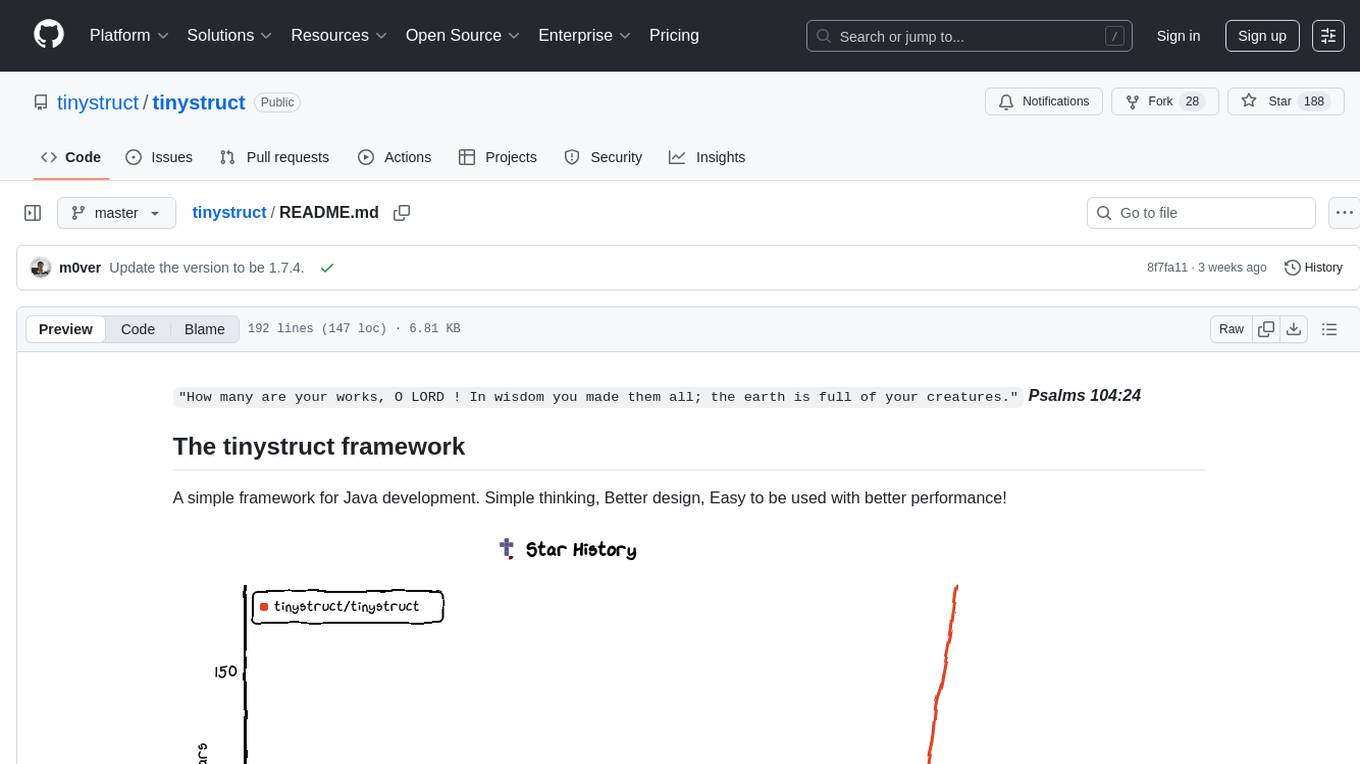
tinystruct
Tinystruct is a simple Java framework designed for easy development with better performance. It offers a modern approach with features like CLI and web integration, built-in lightweight HTTP server, minimal configuration philosophy, annotation-based routing, and performance-first architecture. Developers can focus on real business logic without dealing with unnecessary complexities, making it transparent, predictable, and extensible.
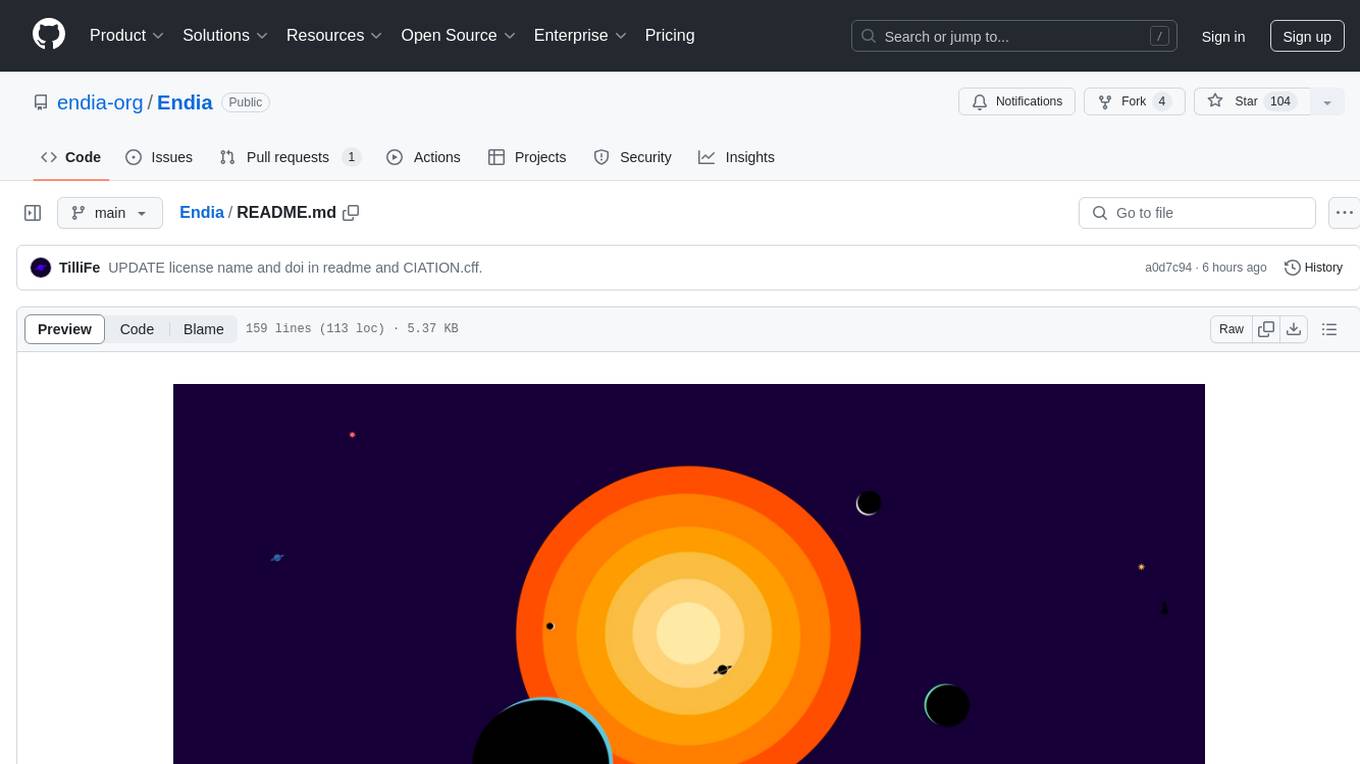
Endia
Endia is a dynamic Array library for Scientific Computing, offering automatic differentiation of arbitrary order, complex number support, dual API with PyTorch-like imperative or JAX-like functional interface, and JIT Compilation for speeding up training and inference. It can handle complex valued functions, perform both forward and reverse-mode automatic differentiation, and has a builtin JIT compiler. Endia aims to advance AI & Scientific Computing by pushing boundaries with clear algorithms, providing high-performance open-source code that remains readable and pythonic, and prioritizing clarity and educational value over exhaustive features.
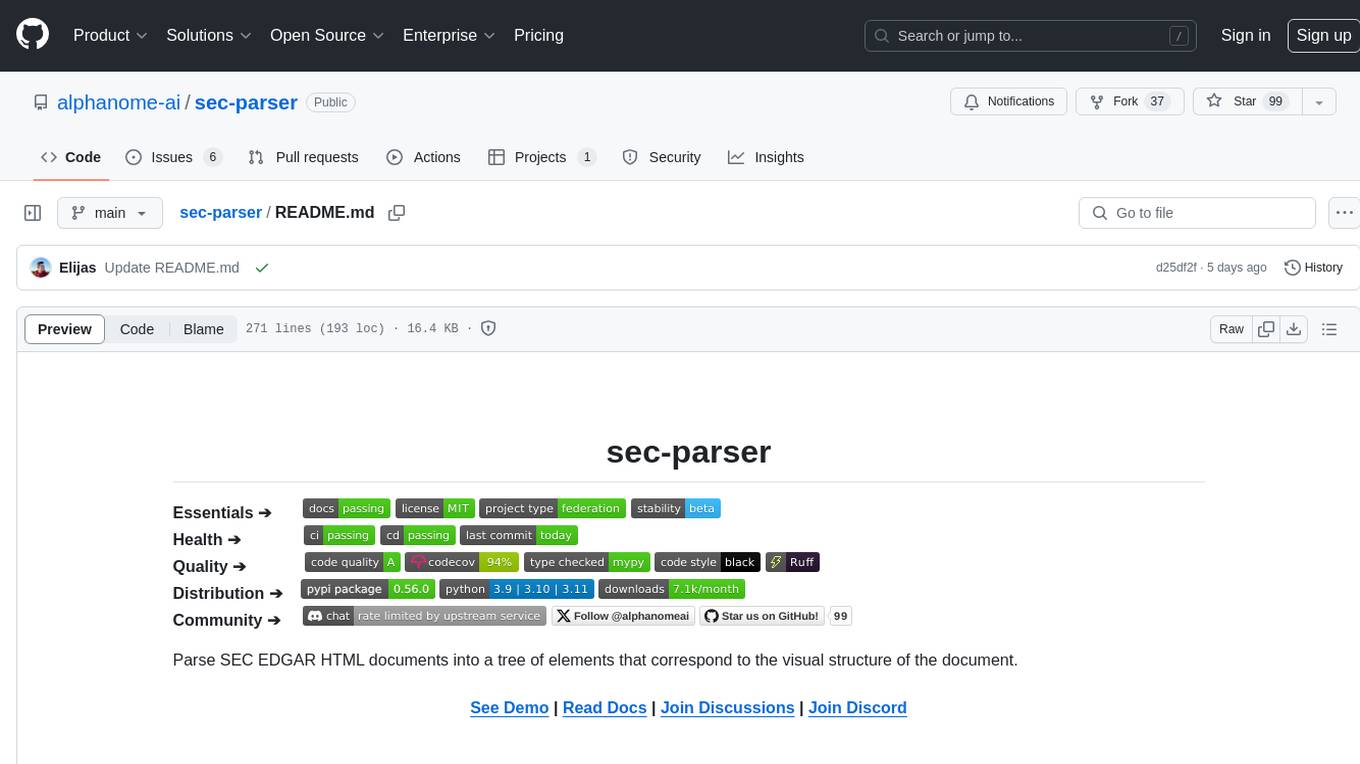
sec-parser
The `sec-parser` project simplifies extracting meaningful information from SEC EDGAR HTML documents by organizing them into semantic elements and a tree structure. It helps in parsing SEC filings for financial and regulatory analysis, analytics and data science, AI and machine learning, causal AI, and large language models. The tool is especially beneficial for AI, ML, and LLM applications by streamlining data pre-processing and feature extraction.
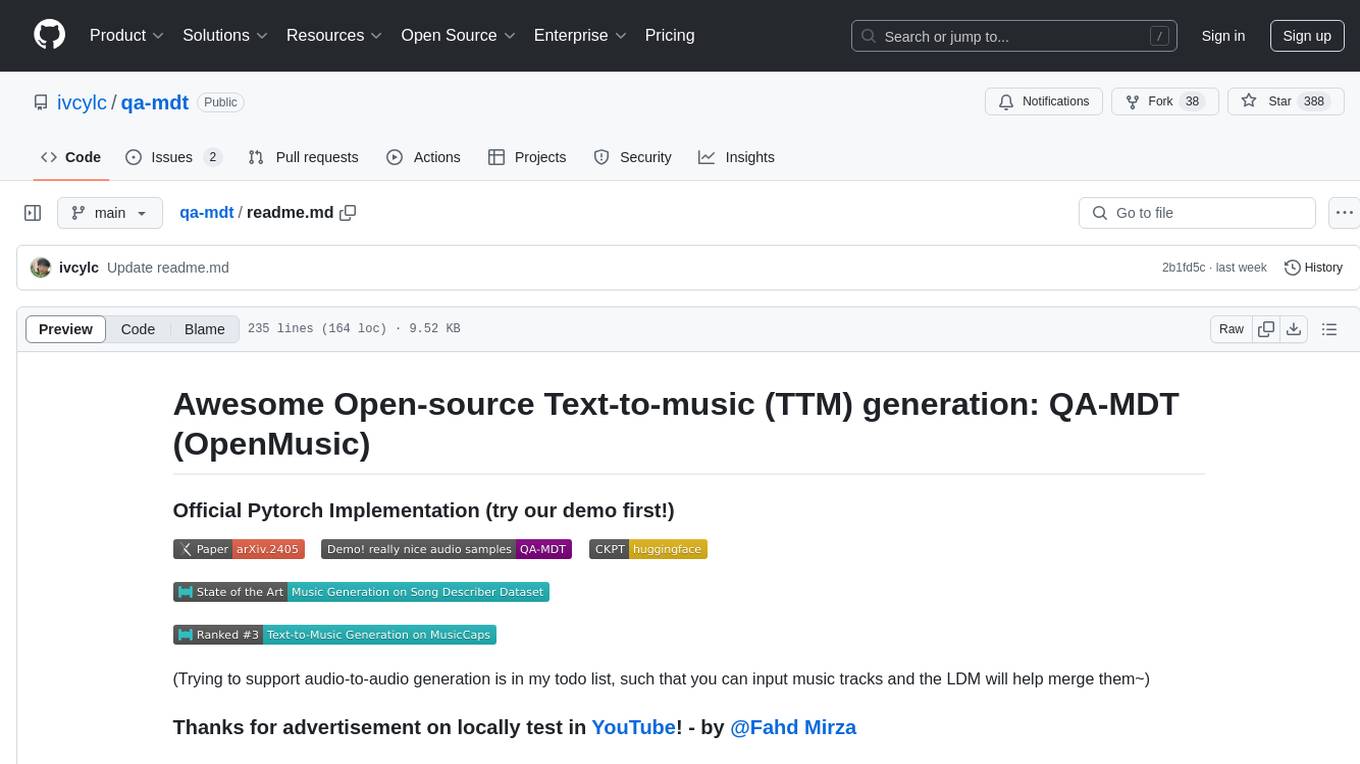
qa-mdt
This repository provides an implementation of QA-MDT, integrating state-of-the-art models for music generation. It offers a Quality-Aware Masked Diffusion Transformer for enhanced music generation. The code is based on various repositories like AudioLDM, PixArt-alpha, MDT, AudioMAE, and Open-Sora. The implementation allows for training and fine-tuning the model with different strategies and datasets. The repository also includes instructions for preparing datasets in LMDB format and provides a script for creating a toy LMDB dataset. The model can be used for music generation tasks, with a focus on quality injection to enhance the musicality of generated music.
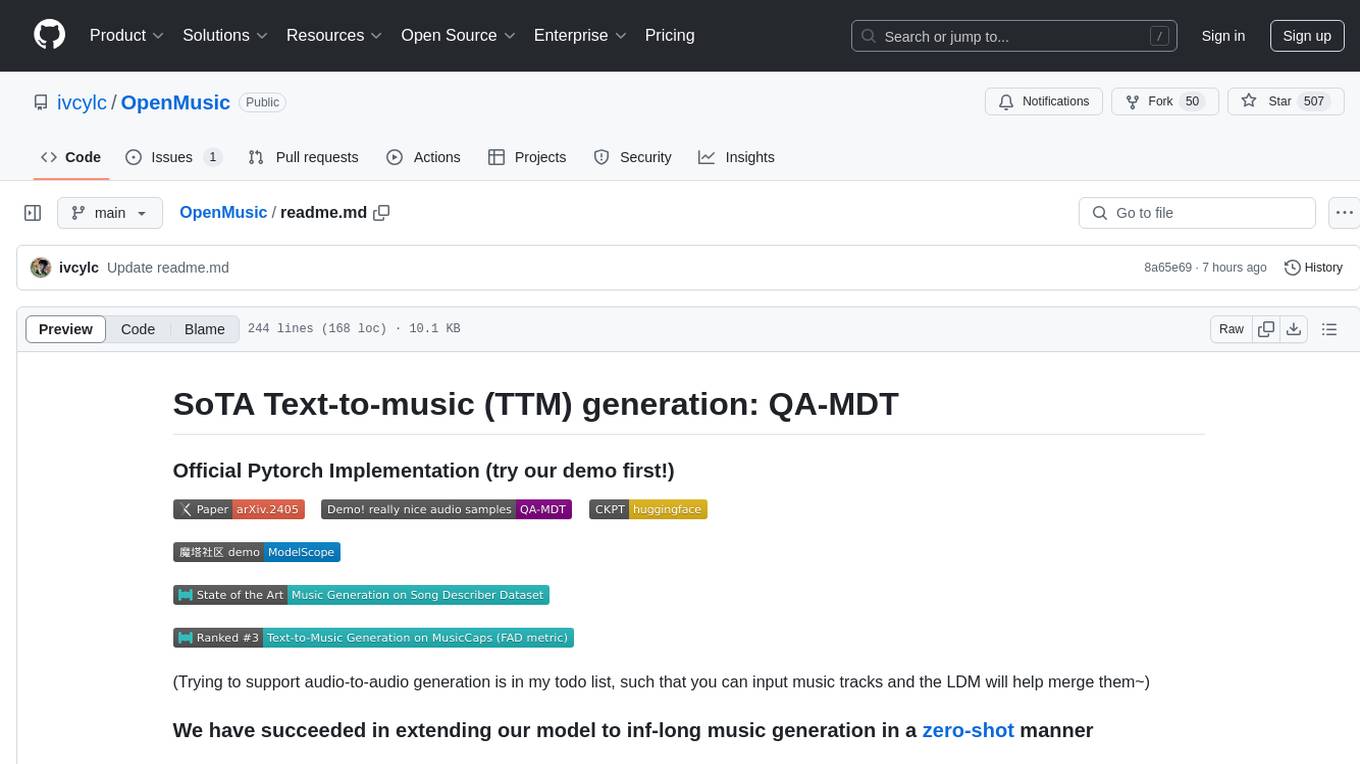
OpenMusic
OpenMusic is a repository providing an implementation of QA-MDT, a Quality-Aware Masked Diffusion Transformer for music generation. The code integrates state-of-the-art models and offers training strategies for music generation. The repository includes implementations of AudioLDM, PixArt-alpha, MDT, AudioMAE, and Open-Sora. Users can train or fine-tune the model using different strategies and datasets. The model is well-pretrained and can be used for music generation tasks. The repository also includes instructions for preparing datasets, training the model, and performing inference. Contact information is provided for any questions or suggestions regarding the project.
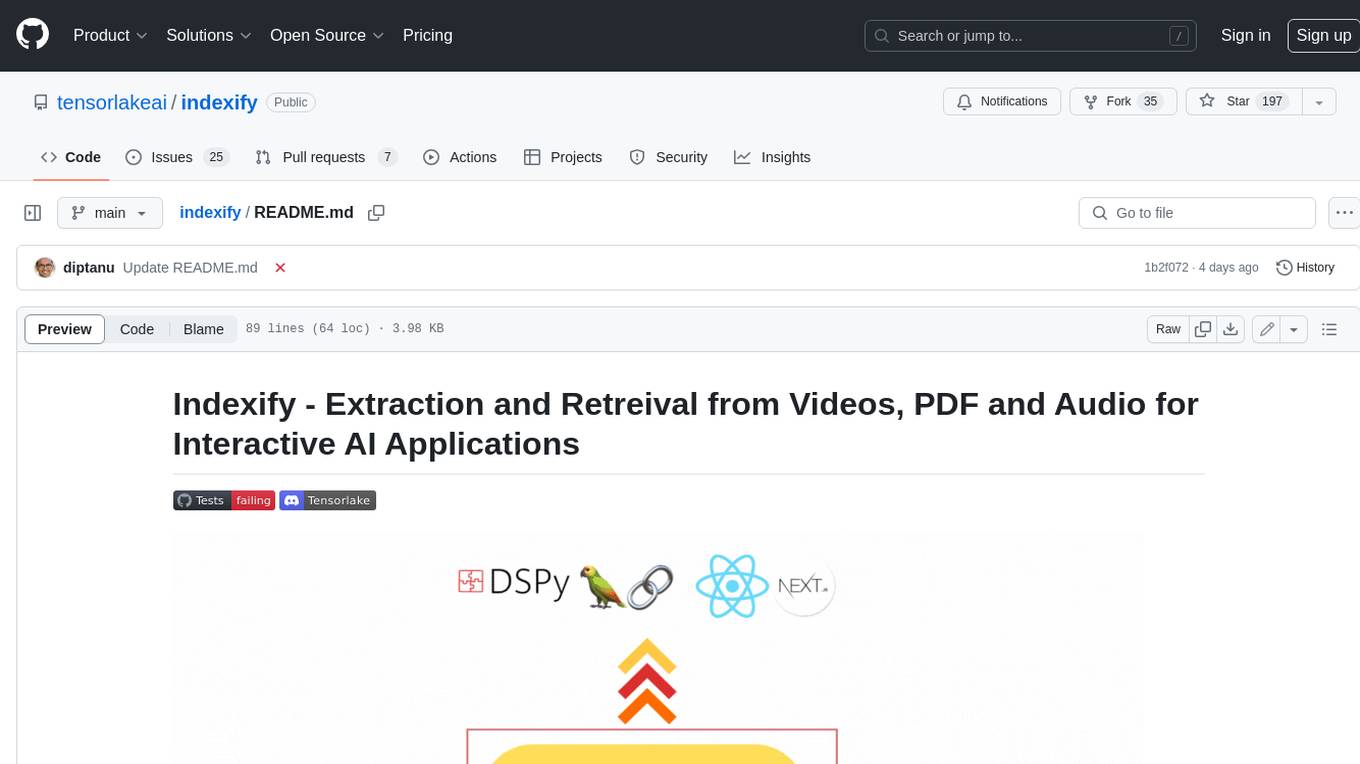
indexify
Indexify is an open-source engine for building fast data pipelines for unstructured data (video, audio, images, and documents) using reusable extractors for embedding, transformation, and feature extraction. LLM Applications can query transformed content friendly to LLMs by semantic search and SQL queries. Indexify keeps vector databases and structured databases (PostgreSQL) updated by automatically invoking the pipelines as new data is ingested into the system from external data sources. **Why use Indexify** * Makes Unstructured Data **Queryable** with **SQL** and **Semantic Search** * **Real-Time** Extraction Engine to keep indexes **automatically** updated as new data is ingested. * Create **Extraction Graph** to describe **data transformation** and extraction of **embedding** and **structured extraction**. * **Incremental Extraction** and **Selective Deletion** when content is deleted or updated. * **Extractor SDK** allows adding new extraction capabilities, and many readily available extractors for **PDF**, **Image**, and **Video** indexing and extraction. * Works with **any LLM Framework** including **Langchain**, **DSPy**, etc. * Runs on your laptop during **prototyping** and also scales to **1000s of machines** on the cloud. * Works with many **Blob Stores**, **Vector Stores**, and **Structured Databases** * We have even **Open Sourced Automation** to deploy to Kubernetes in production.
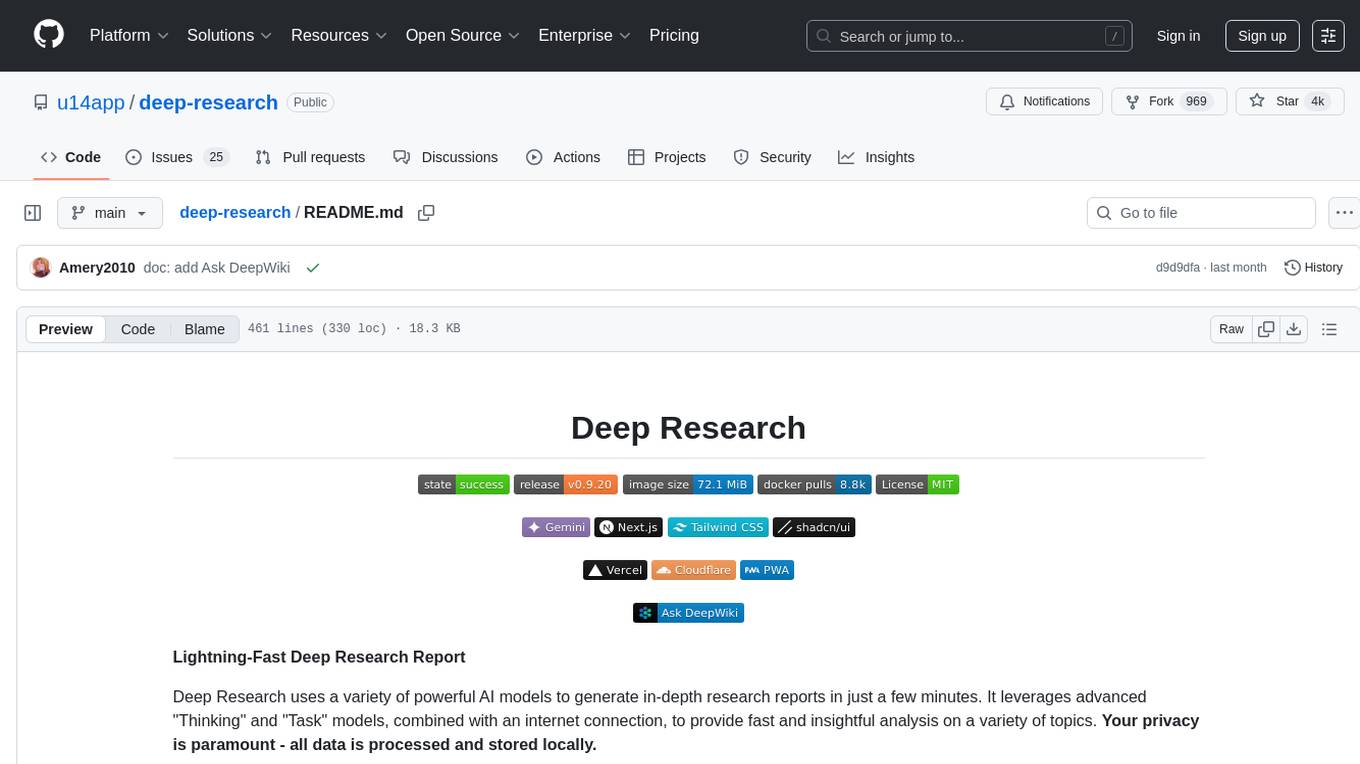
deep-research
Deep Research is a lightning-fast tool that uses powerful AI models to generate comprehensive research reports in just a few minutes. It leverages advanced 'Thinking' and 'Task' models, combined with an internet connection, to provide fast and insightful analysis on various topics. The tool ensures privacy by processing and storing all data locally. It supports multi-platform deployment, offers support for various large language models, web search functionality, knowledge graph generation, research history preservation, local and server API support, PWA technology, multi-key payload support, multi-language support, and is built with modern technologies like Next.js and Shadcn UI. Deep Research is open-source under the MIT License.
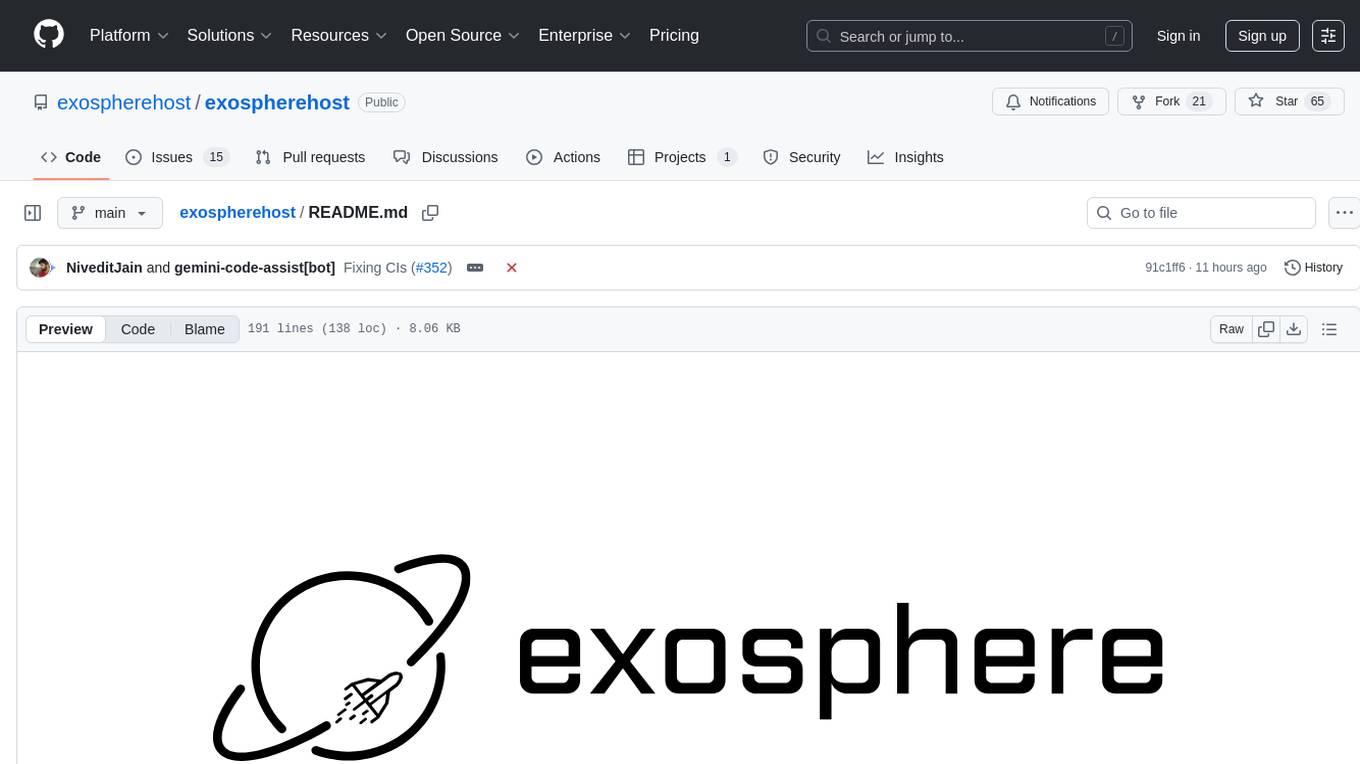
exospherehost
Exosphere is an open source infrastructure designed to run AI agents at scale for large data and long running flows. It allows developers to define plug and playable nodes that can be run on a reliable backbone in the form of a workflow, with features like dynamic state creation at runtime, infinite parallel agents, persistent state management, and failure handling. This enables the deployment of production agents that can scale beautifully to build robust autonomous AI workflows.
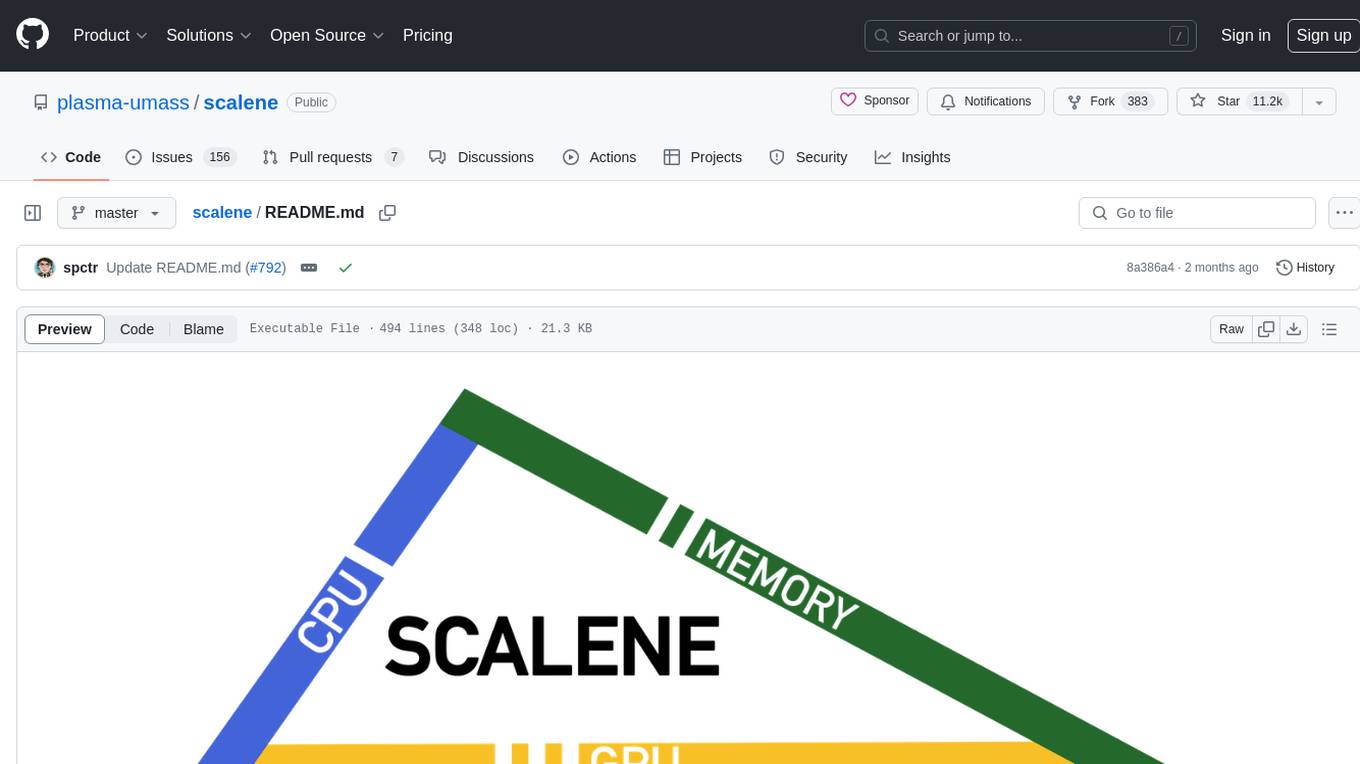
scalene
Scalene is a high-performance CPU, GPU, and memory profiler for Python that provides detailed information and runs faster than many other profilers. It incorporates AI-powered proposed optimizations, allowing users to generate optimization suggestions by clicking on specific lines or regions of code. Scalene separates time spent in Python from native code, highlights hotspots, and identifies memory usage per line. It supports GPU profiling on NVIDIA-based systems and detects memory leaks. Users can generate reduced profiles, profile specific functions using decorators, and suspend/resume profiling for background processes. Scalene is available as a pip or conda package and works on various platforms. It offers features like profiling at the line level, memory trends, copy volume reporting, and leak detection.
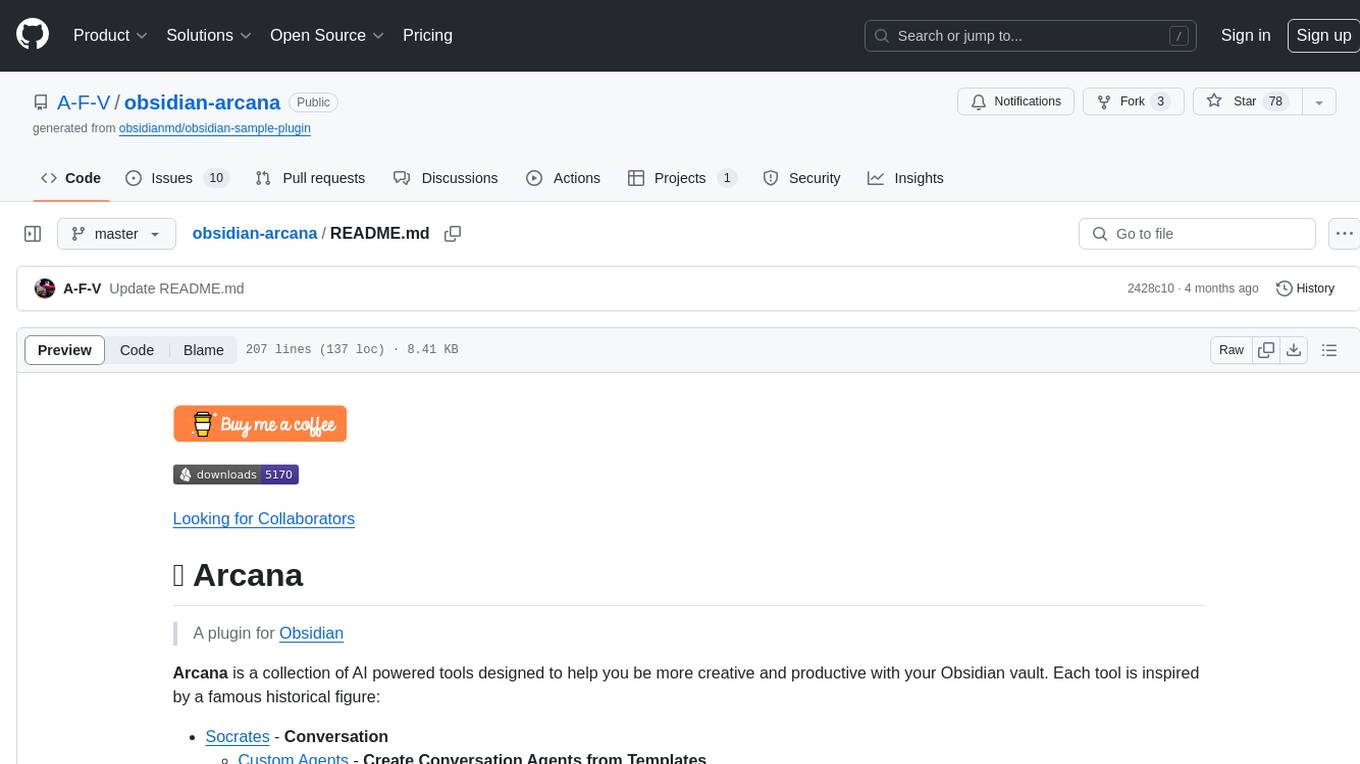
obsidian-arcana
Arcana is a plugin for Obsidian that offers a collection of AI-powered tools inspired by famous historical figures to enhance creativity and productivity. It includes tools for conversation, text-to-speech transcription, speech-to-text replies, metadata markup, text generation, file moving, flashcard generation, auto tagging, and note naming. Users can interact with these tools using the command palette and sidebar views, with an OpenAI API key required for usage. The plugin aims to assist users in various note-taking and knowledge management tasks within the Obsidian vault environment.
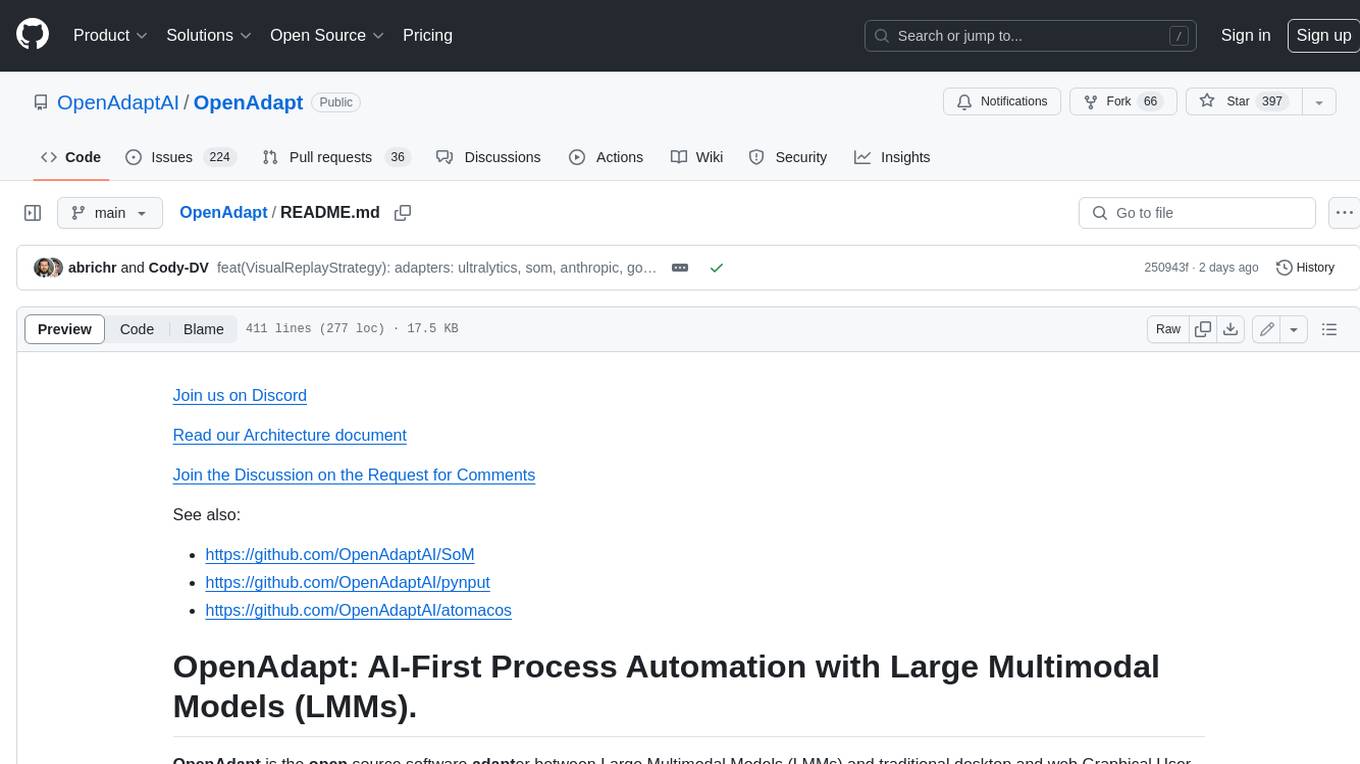
OpenAdapt
OpenAdapt is an open-source software adapter between Large Multimodal Models (LMMs) and traditional desktop and web Graphical User Interfaces (GUIs). It aims to automate repetitive GUI workflows by leveraging the power of LMMs. OpenAdapt records user input and screenshots, converts them into tokenized format, and generates synthetic input via transformer model completions. It also analyzes recordings to generate task trees and replay synthetic input to complete tasks. OpenAdapt is model agnostic and generates prompts automatically by learning from human demonstration, ensuring that agents are grounded in existing processes and mitigating hallucinations. It works with all types of desktop GUIs, including virtualized and web, and is open source under the MIT license.
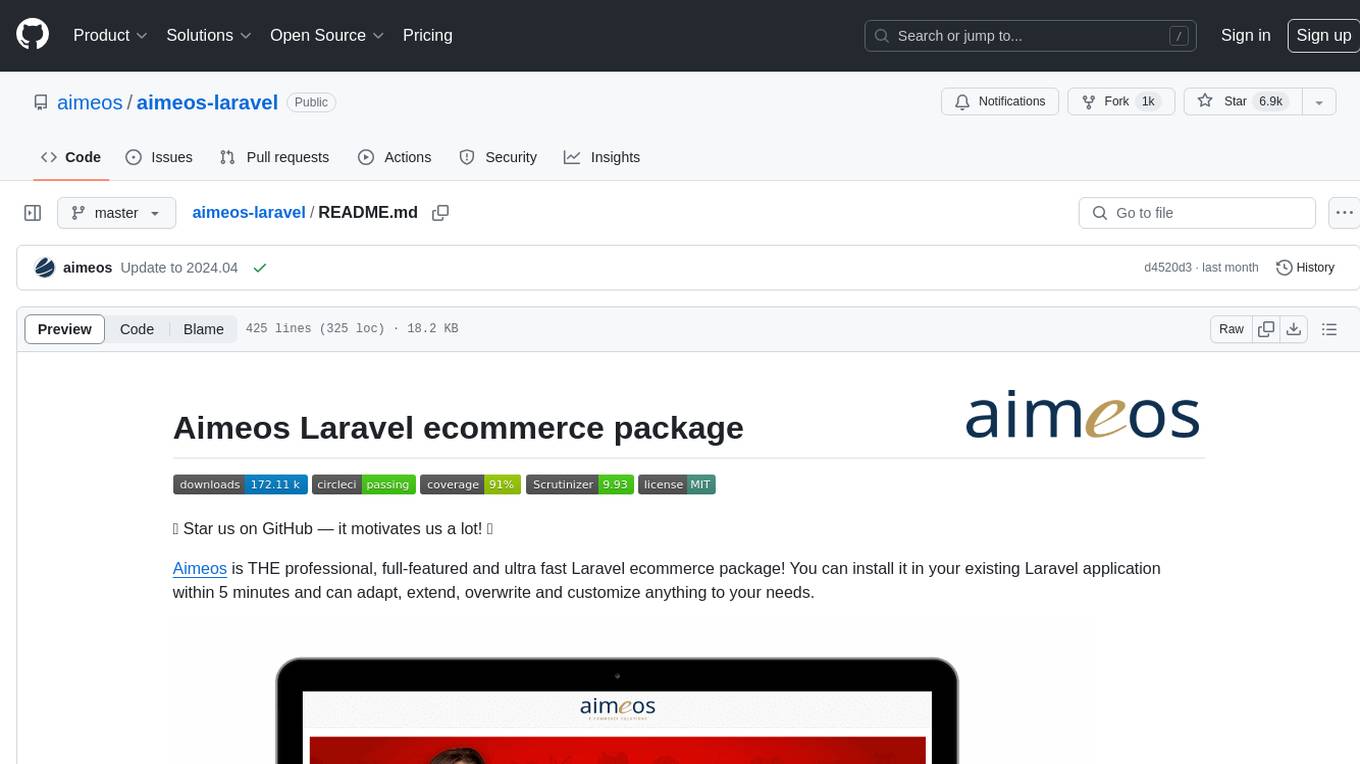
aimeos-laravel
Aimeos Laravel is a professional, full-featured, and ultra-fast Laravel ecommerce package that can be easily integrated into existing Laravel applications. It offers a wide range of features including multi-vendor, multi-channel, and multi-warehouse support, fast performance, support for various product types, subscriptions with recurring payments, multiple payment gateways, full RTL support, flexible pricing options, admin backend, REST and GraphQL APIs, modular structure, SEO optimization, multi-language support, AI-based text translation, mobile optimization, and high-quality source code. The package is highly configurable and extensible, making it suitable for e-commerce SaaS solutions, marketplaces, and online shops with millions of vendors.
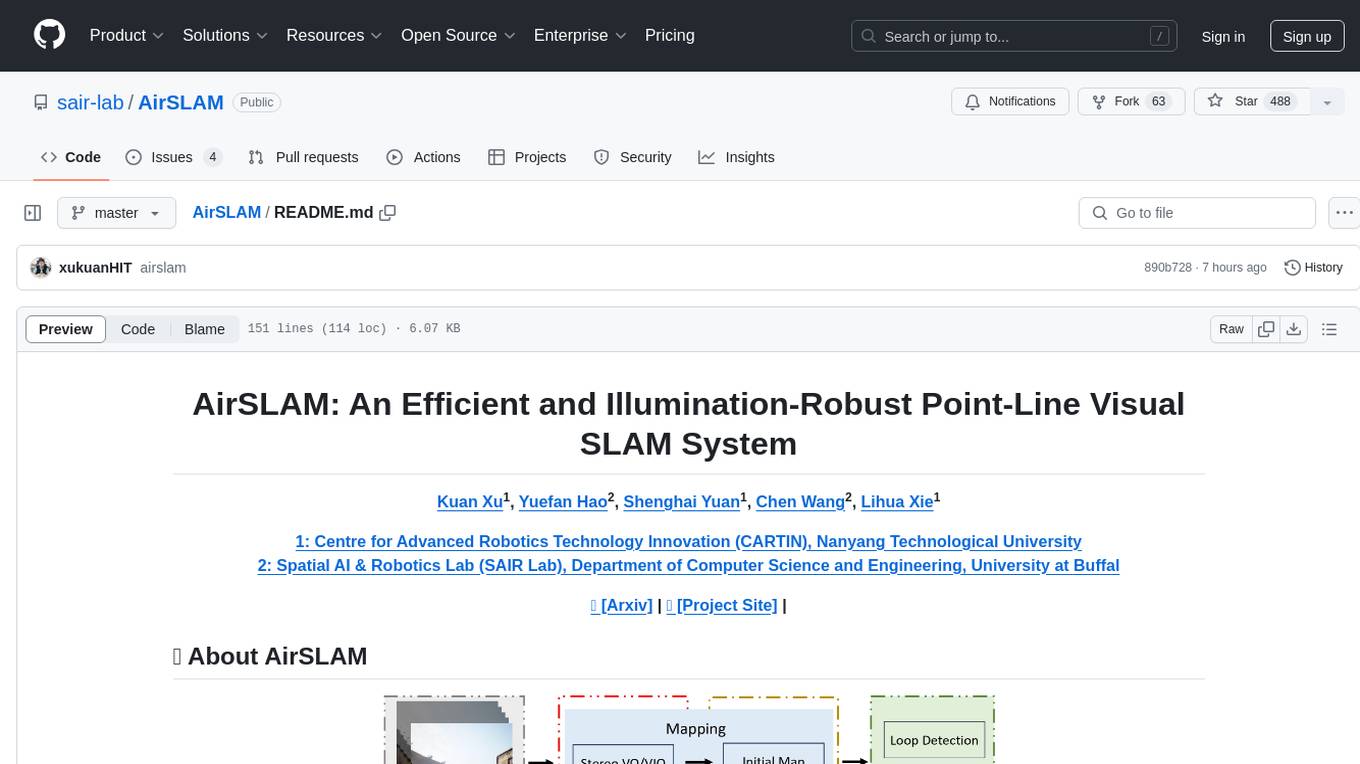
AirSLAM
AirSLAM is an efficient visual SLAM system designed to tackle short-term and long-term illumination challenges. It combines deep learning techniques with traditional optimization methods, featuring a unified CNN for keypoint and structural line extraction. The system includes a relocalization pipeline for map reuse, accelerated using C++ and NVIDIA TensorRT. Outperforming other SLAM systems in challenging environments, it runs at 73Hz on PC and 40Hz on embedded platforms.

maiar-ai
MAIAR is a composable, plugin-based AI agent framework designed to abstract data ingestion, decision-making, and action execution into modular plugins. It enables developers to define triggers and actions as standalone plugins, while the core runtime handles decision-making dynamically. This framework offers extensibility, composability, and model-driven behavior, allowing seamless addition of new functionality. MAIAR's architecture is influenced by Unix pipes, ensuring highly composable plugins, dynamic execution pipelines, and transparent debugging. It remains declarative and extensible, allowing developers to build complex AI workflows without rigid architectures.
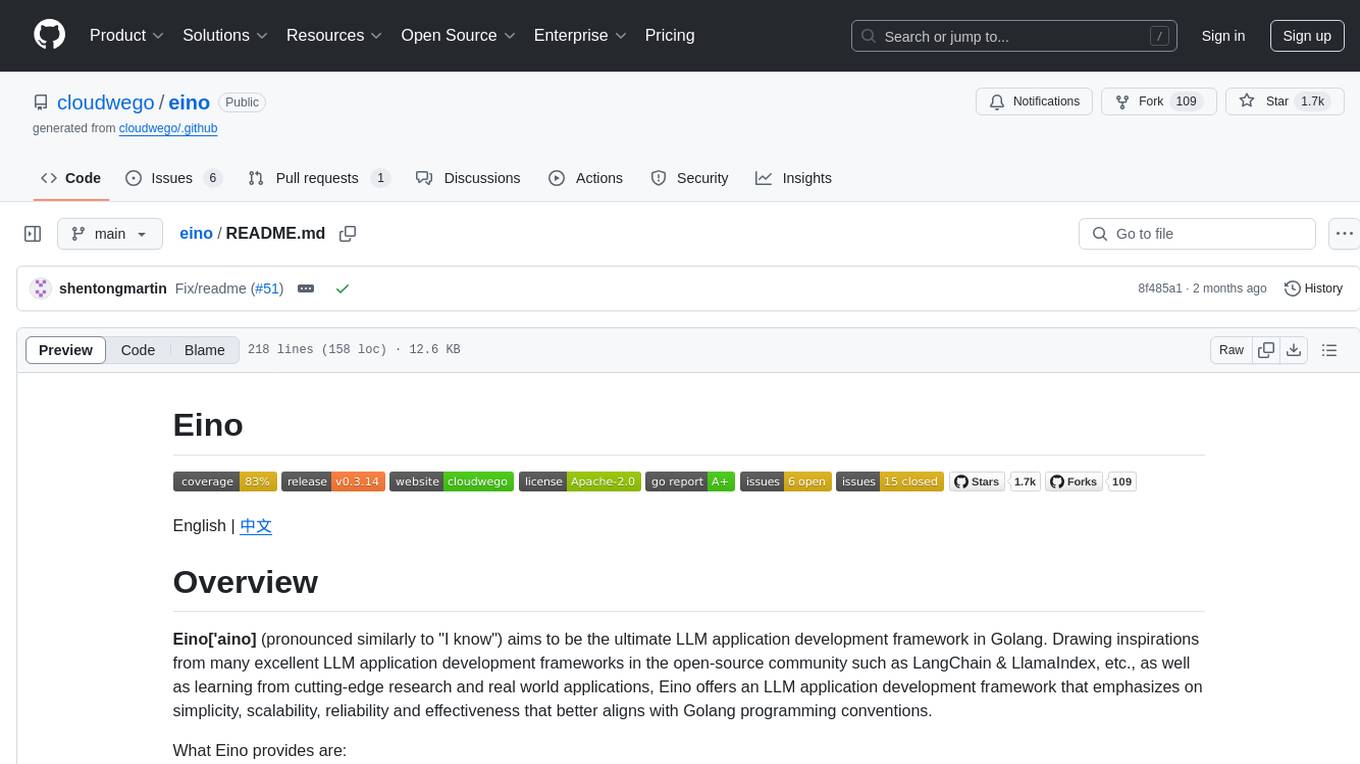
eino
Eino is an ultimate LLM application development framework in Golang, emphasizing simplicity, scalability, reliability, and effectiveness. It provides a curated list of component abstractions, a powerful composition framework, meticulously designed APIs, best practices, and tools covering the entire development cycle. Eino standardizes and improves efficiency in AI application development by offering rich components, powerful orchestration, complete stream processing, highly extensible aspects, and a comprehensive framework structure.
For similar tasks

obsidian-quiz-generator
Quiz Generator is a plugin for Obsidian that uses AI models to create interactive exam-style questions from notes. It supports various question types and provides real-time feedback. Users can save questions, generate in multiple languages, and use math support. The tool is suitable for students preparing for exams and educators designing assessments.
For similar jobs
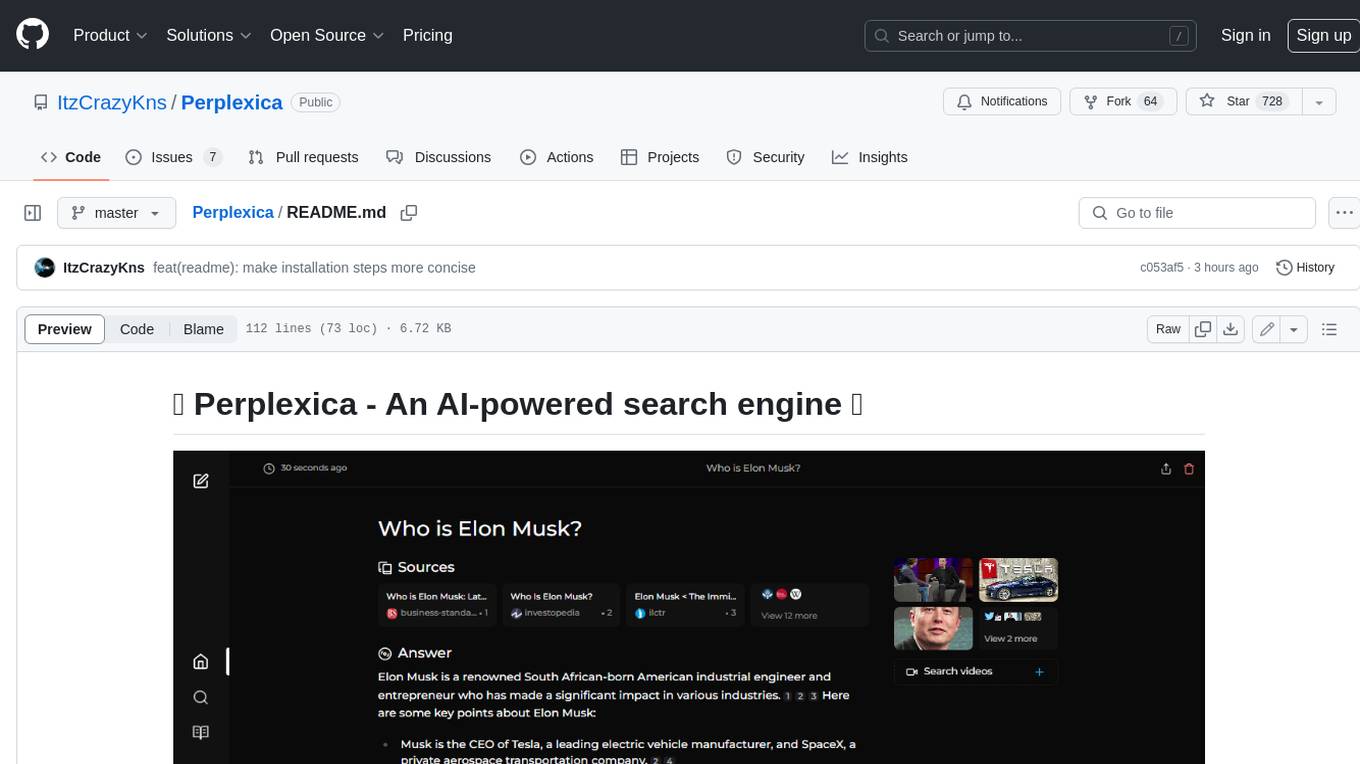
Perplexica
Perplexica is an open-source AI-powered search engine that utilizes advanced machine learning algorithms to provide clear answers with sources cited. It offers various modes like Copilot Mode, Normal Mode, and Focus Modes for specific types of questions. Perplexica ensures up-to-date information by using SearxNG metasearch engine. It also features image and video search capabilities and upcoming features include finalizing Copilot Mode and adding Discover and History Saving features.
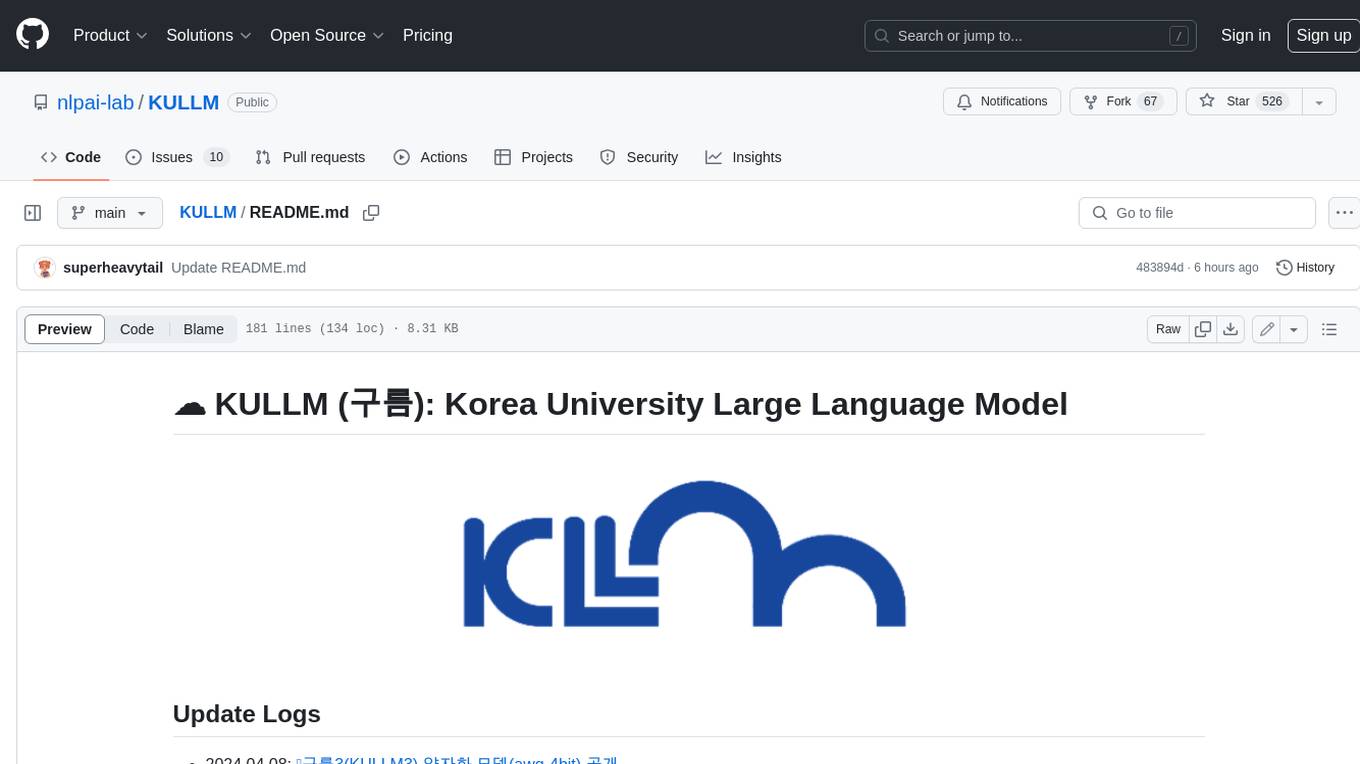
KULLM
KULLM (구름) is a Korean Large Language Model developed by Korea University NLP & AI Lab and HIAI Research Institute. It is based on the upstage/SOLAR-10.7B-v1.0 model and has been fine-tuned for instruction. The model has been trained on 8×A100 GPUs and is capable of generating responses in Korean language. KULLM exhibits hallucination and repetition phenomena due to its decoding strategy. Users should be cautious as the model may produce inaccurate or harmful results. Performance may vary in benchmarks without a fixed system prompt.
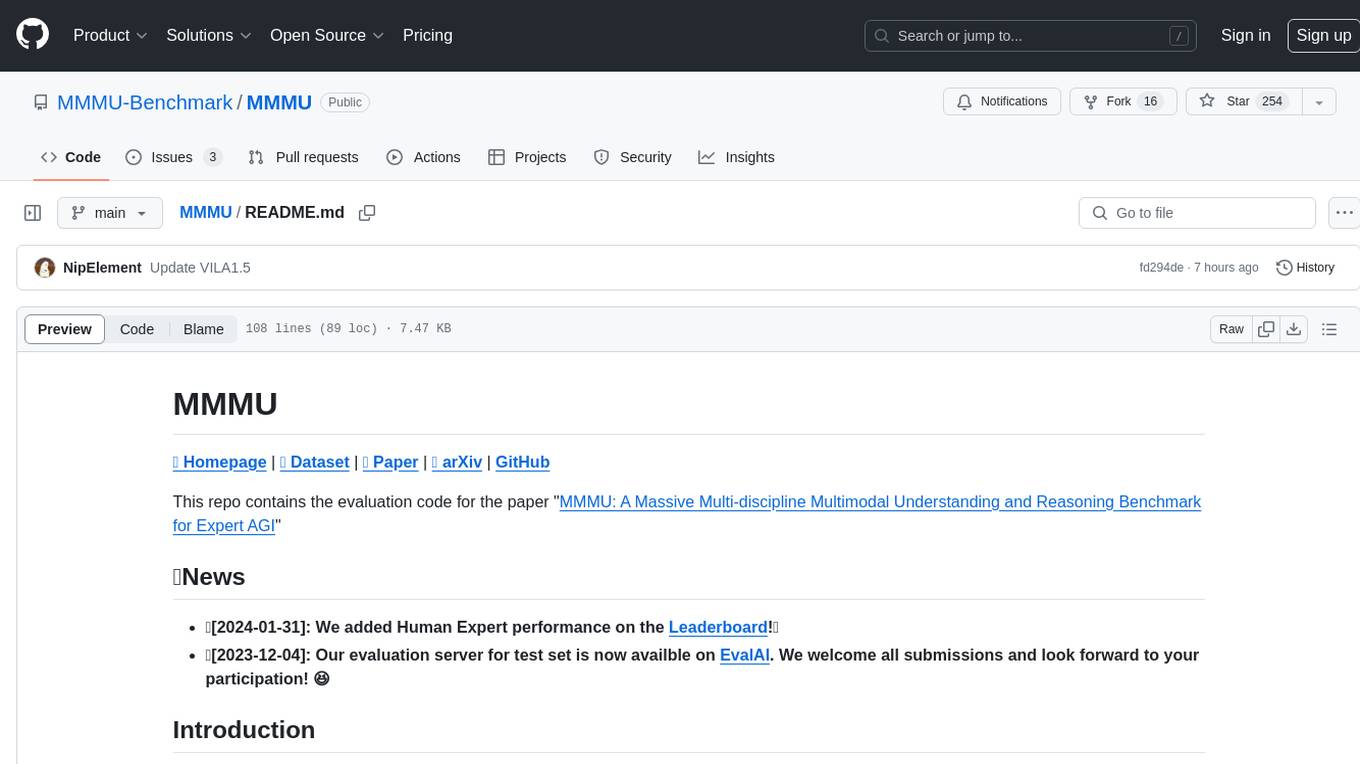
MMMU
MMMU is a benchmark designed to evaluate multimodal models on college-level subject knowledge tasks, covering 30 subjects and 183 subfields with 11.5K questions. It focuses on advanced perception and reasoning with domain-specific knowledge, challenging models to perform tasks akin to those faced by experts. The evaluation of various models highlights substantial challenges, with room for improvement to stimulate the community towards expert artificial general intelligence (AGI).
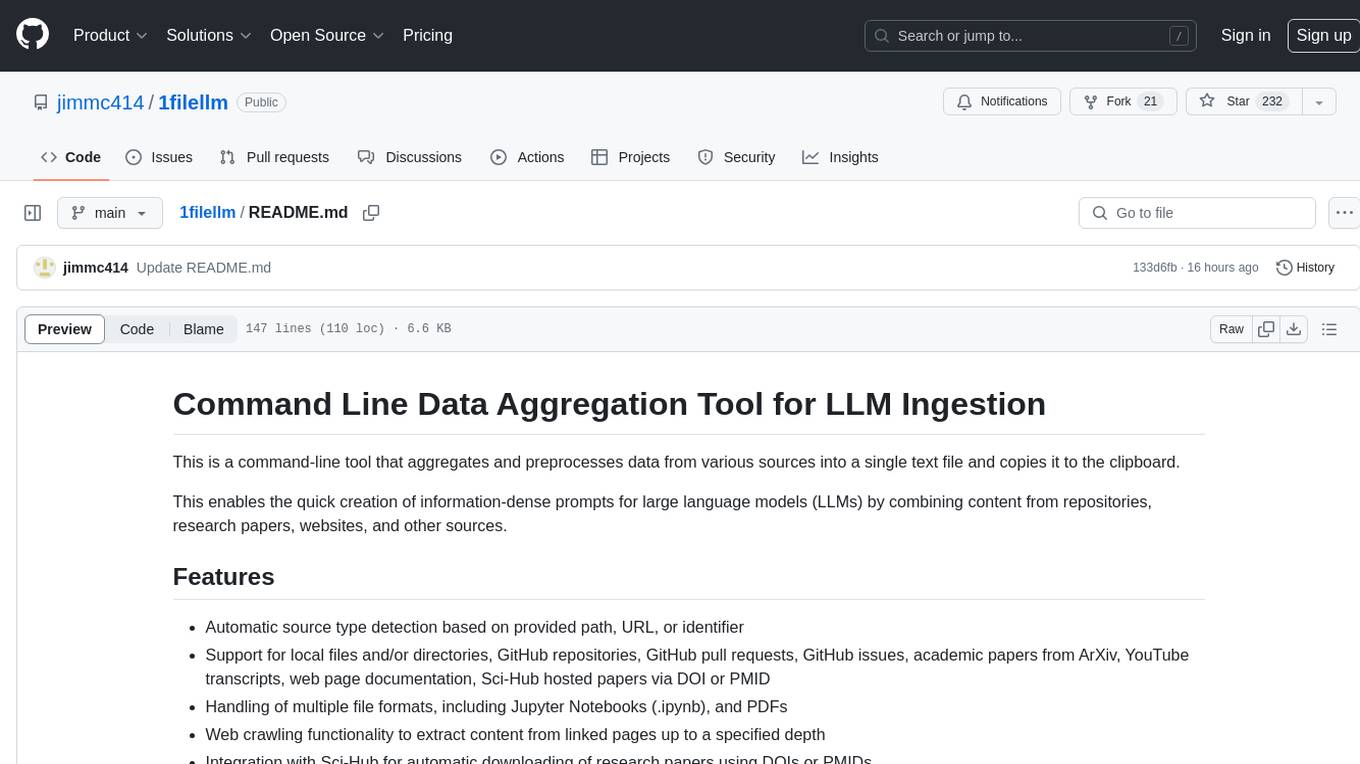
1filellm
1filellm is a command-line data aggregation tool designed for LLM ingestion. It aggregates and preprocesses data from various sources into a single text file, facilitating the creation of information-dense prompts for large language models. The tool supports automatic source type detection, handling of multiple file formats, web crawling functionality, integration with Sci-Hub for research paper downloads, text preprocessing, and token count reporting. Users can input local files, directories, GitHub repositories, pull requests, issues, ArXiv papers, YouTube transcripts, web pages, Sci-Hub papers via DOI or PMID. The tool provides uncompressed and compressed text outputs, with the uncompressed text automatically copied to the clipboard for easy pasting into LLMs.
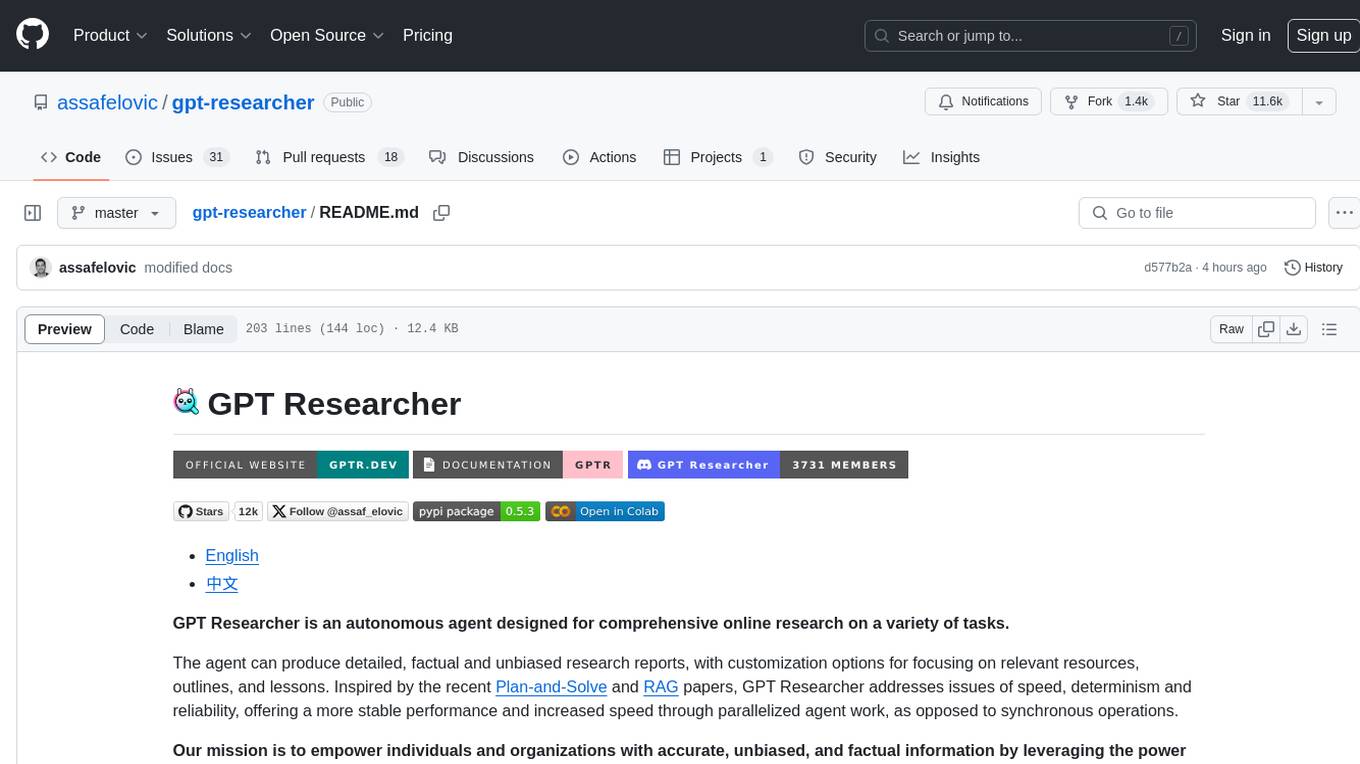
gpt-researcher
GPT Researcher is an autonomous agent designed for comprehensive online research on a variety of tasks. It can produce detailed, factual, and unbiased research reports with customization options. The tool addresses issues of speed, determinism, and reliability by leveraging parallelized agent work. The main idea involves running 'planner' and 'execution' agents to generate research questions, seek related information, and create research reports. GPT Researcher optimizes costs and completes tasks in around 3 minutes. Features include generating long research reports, aggregating web sources, an easy-to-use web interface, scraping web sources, and exporting reports to various formats.
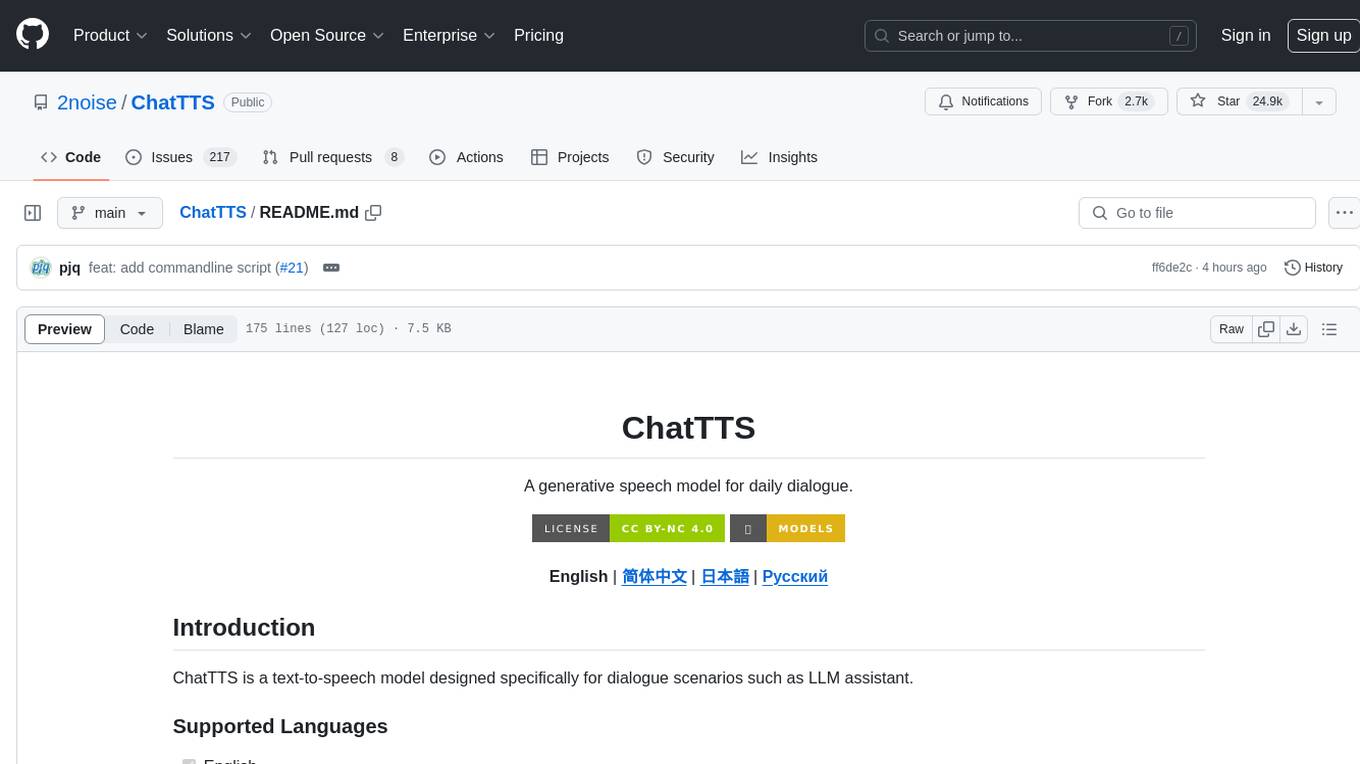
ChatTTS
ChatTTS is a generative speech model optimized for dialogue scenarios, providing natural and expressive speech synthesis with fine-grained control over prosodic features. It supports multiple speakers and surpasses most open-source TTS models in terms of prosody. The model is trained with 100,000+ hours of Chinese and English audio data, and the open-source version on HuggingFace is a 40,000-hour pre-trained model without SFT. The roadmap includes open-sourcing additional features like VQ encoder, multi-emotion control, and streaming audio generation. The tool is intended for academic and research use only, with precautions taken to limit potential misuse.
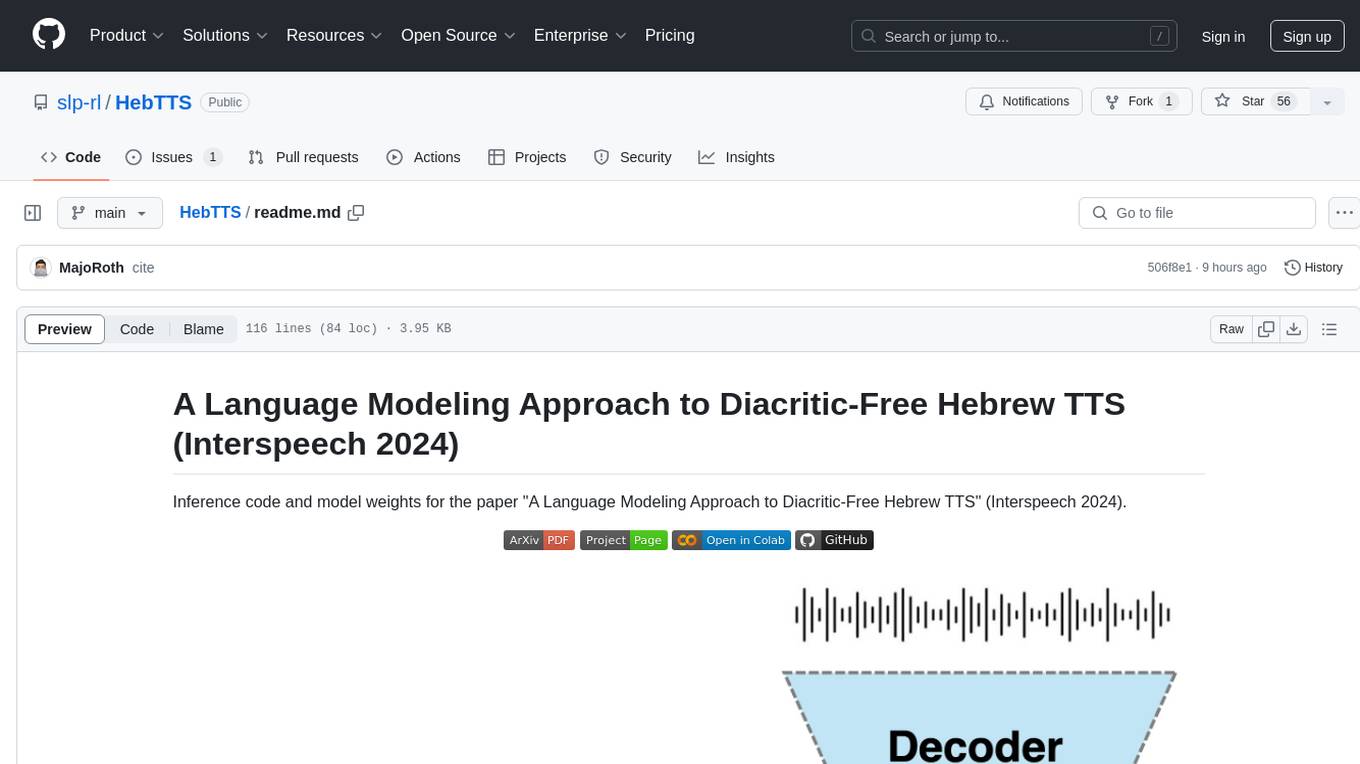
HebTTS
HebTTS is a language modeling approach to diacritic-free Hebrew text-to-speech (TTS) system. It addresses the challenge of accurately mapping text to speech in Hebrew by proposing a language model that operates on discrete speech representations and is conditioned on a word-piece tokenizer. The system is optimized using weakly supervised recordings and outperforms diacritic-based Hebrew TTS systems in terms of content preservation and naturalness of generated speech.
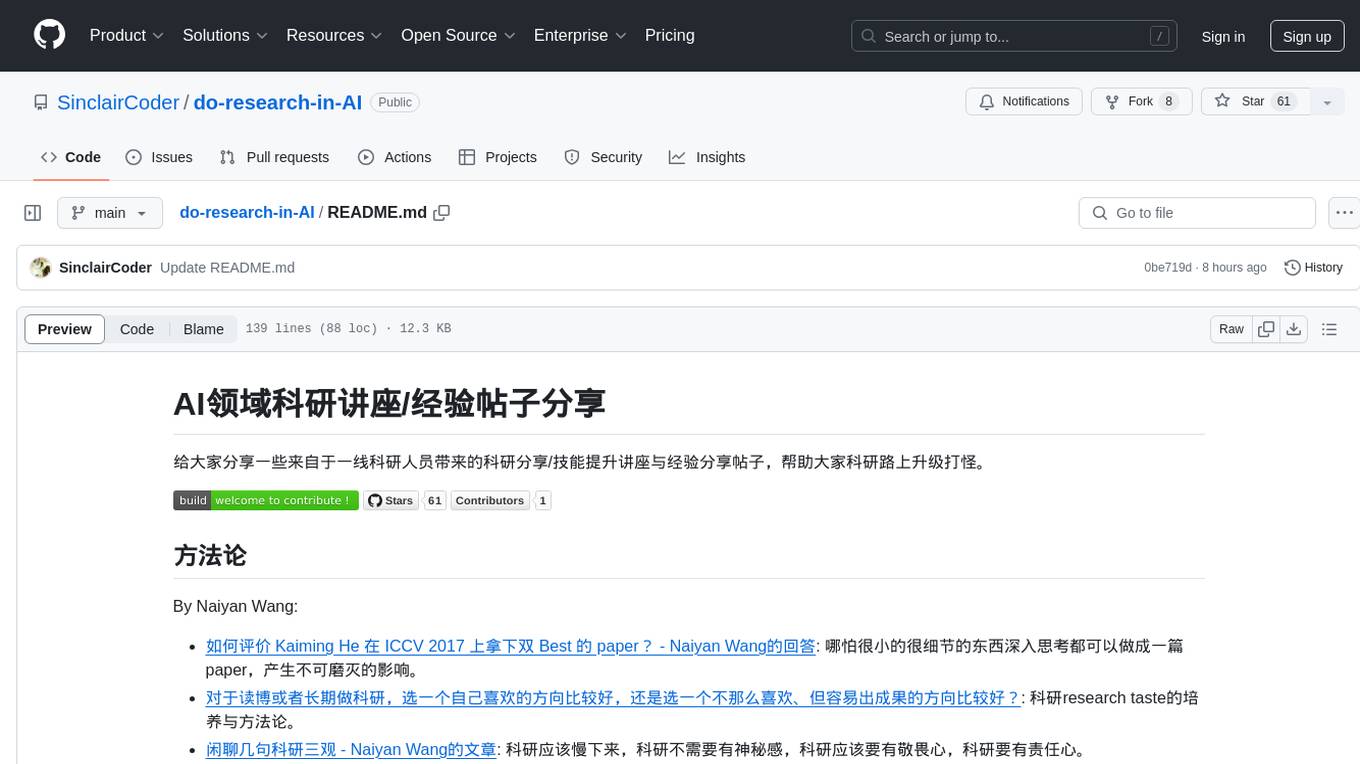
do-research-in-AI
This repository is a collection of research lectures and experience sharing posts from frontline researchers in the field of AI. It aims to help individuals upgrade their research skills and knowledge through insightful talks and experiences shared by experts. The content covers various topics such as evaluating research papers, choosing research directions, research methodologies, and tips for writing high-quality scientific papers. The repository also includes discussions on academic career paths, research ethics, and the emotional aspects of research work. Overall, it serves as a valuable resource for individuals interested in advancing their research capabilities in the field of AI.

